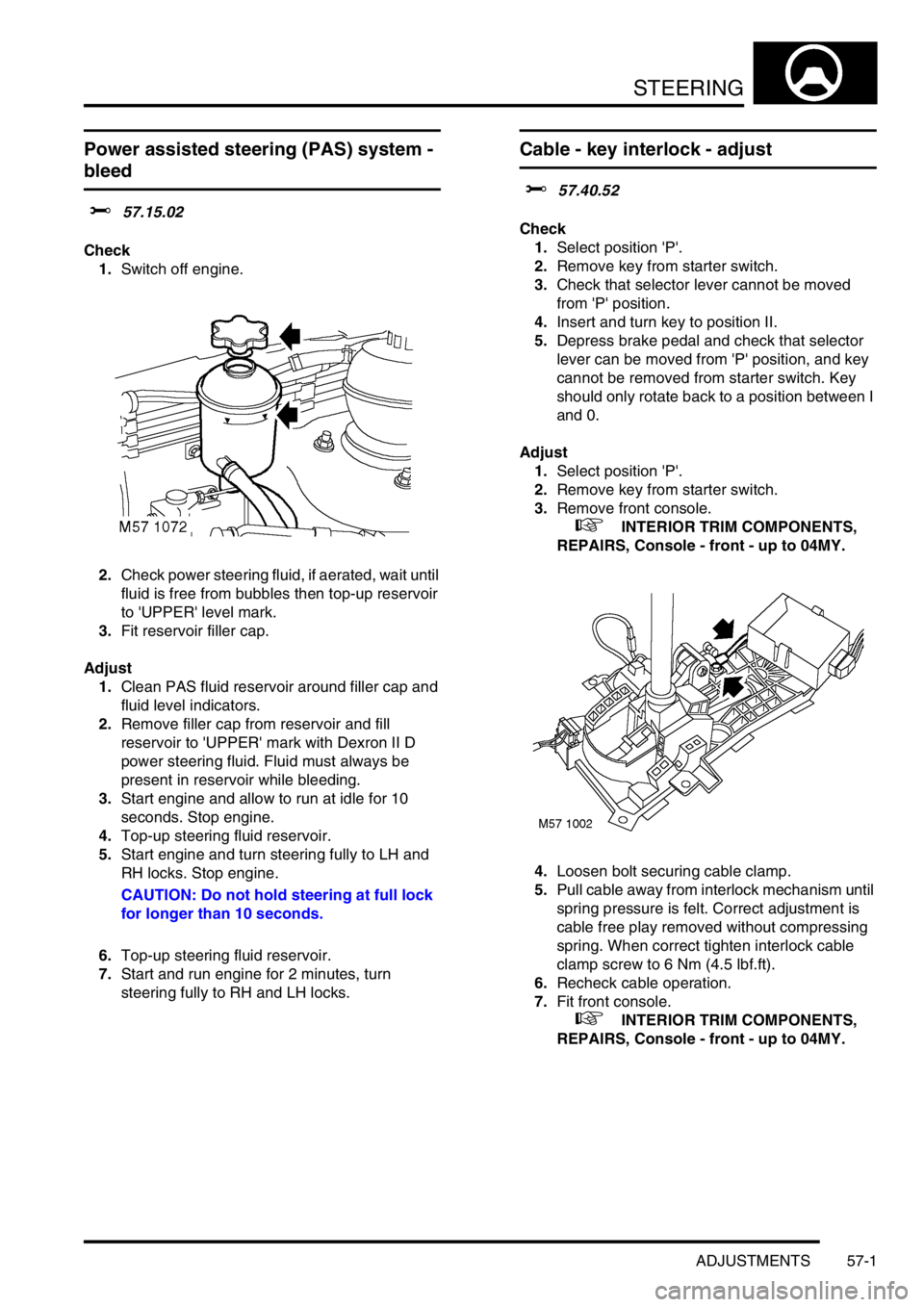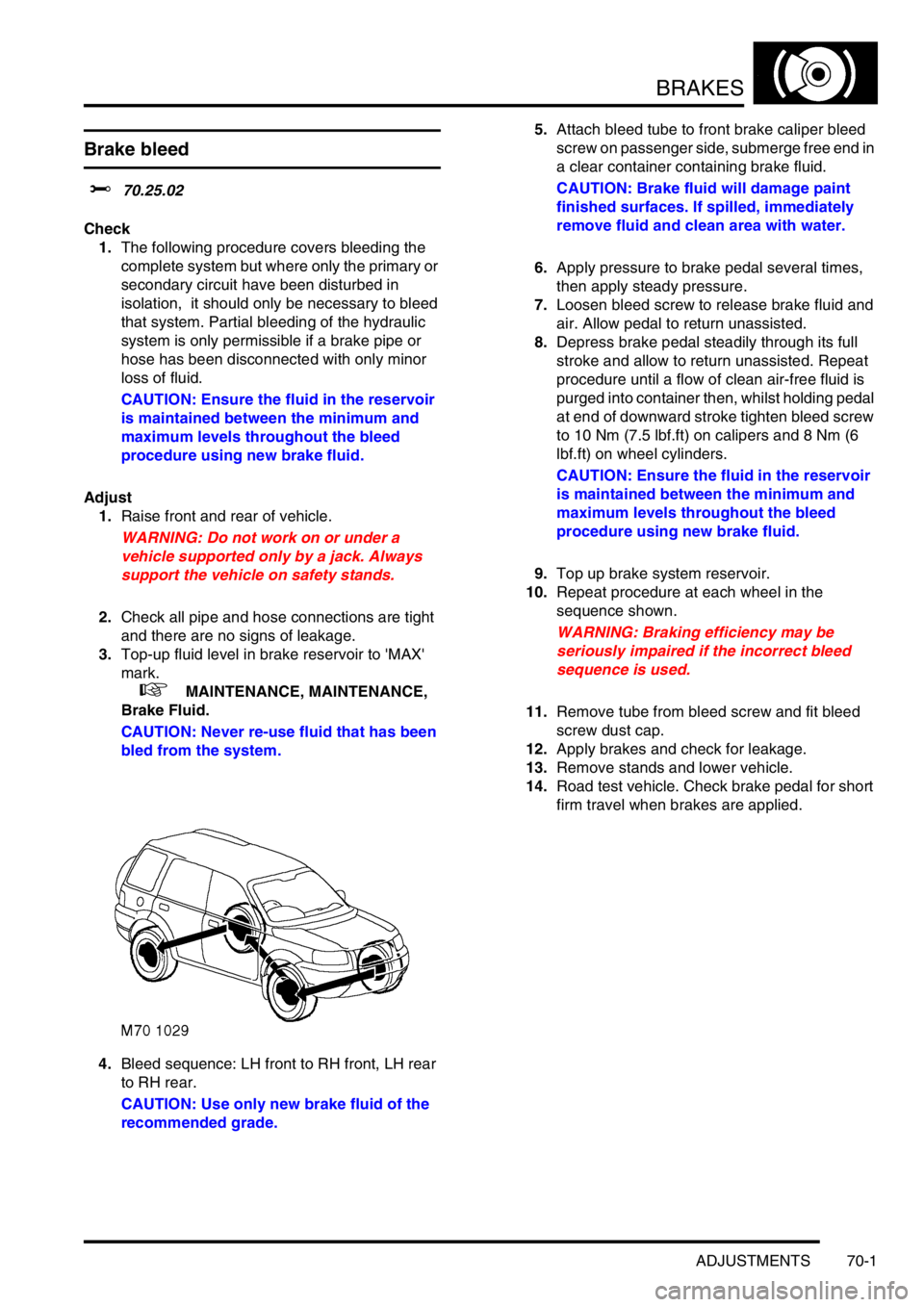air bleeding LAND ROVER FREELANDER 2001 Workshop Manual
[x] Cancel search | Manufacturer: LAND ROVER, Model Year: 2001, Model line: FREELANDER, Model: LAND ROVER FREELANDER 2001Pages: 1007, PDF Size: 23.47 MB
Page 494 of 1007

STEERING
ADJUSTMENTS 57-1
STEERING ADJUST ME NTS
Power assisted steering (PAS) system -
bleed
$% 57.15.02
Check
1.Switch off engine.
2.Check power steering fluid, if aerated, wait until
fluid is free from bubbles then top-up reservoir
to 'UPPER' level mark.
3.Fit reservoir filler cap.
Adjust
1.Clean PAS fluid reservoir around filler cap and
fluid level indicators.
2.Remove filler cap from reservoir and fill
reservoir to 'UPPER' mark with Dexron II D
power steering fluid. Fluid must always be
present in reservoir while bleeding.
3.Start engine and allow to run at idle for 10
seconds. Stop engine.
4.Top-up steering fluid reservoir.
5.Start engine and turn steering fully to LH and
RH locks. Stop engine.
CAUTION: Do not hold steering at full lock
for longer than 10 seconds.
6.Top-up steering fluid reservoir.
7.Start and run engine for 2 minutes, turn
steering fully to RH and LH locks.
Cable - key interlock - adjust
$% 57.40.52
Check
1.Select position 'P'.
2.Remove key from starter switch.
3.Check that selector lever cannot be moved
from 'P' position.
4.Insert and turn key to position II.
5.Depress brake pedal and check that selector
lever can be moved from 'P' position, and key
cannot be removed from starter switch. Key
should only rotate back to a position between I
and 0.
Adjust
1.Select position 'P'.
2.Remove key from starter switch.
3.Remove front console.
+ INTERIOR TRIM COMPONENTS,
REPAIRS, Console - front - up to 04MY.
4.Loosen bolt securing cable clamp.
5.Pull cable away from interlock mechanism until
spring pressure is felt. Correct adjustment is
cable free play removed without compressing
spring. When correct tighten interlock cable
clamp screw to 6 Nm (4.5 lbf.ft).
6.Recheck cable operation.
7.Fit front console.
+ INTERIOR TRIM COMPONENTS,
REPAIRS, Console - front - up to 04MY.
Page 550 of 1007

BRAKES
ADJUSTMENTS 70-1
BRAKES ADJUST ME NTS
Brake bleed
$% 70.25.02
Check
1.The following procedure covers bleeding the
complete system but where only the primary or
secondary circuit have been disturbed in
isolation, it should only be necessary to bleed
that system. Partial bleeding of the hydraulic
system is only permissible if a brake pipe or
hose has been disconnected with only minor
loss of fluid.
CAUTION: Ensure the fluid in the reservoir
is maintained between the minimum and
maximum levels throughout the bleed
procedure using new brake fluid.
Adjust
1.Raise front and rear of vehicle.
WARNING: Do not work on or under a
vehicle supported only by a jack. Always
support the vehicle on safety stands.
2.Check all pipe and hose connections are tight
and there are no signs of leakage.
3.Top-up fluid level in brake reservoir to 'MAX'
mark.
+ MAINTENANCE, MAINTENANCE,
Brake Fluid.
CAUTION: Never re-use fluid that has been
bled from the system.
4.Bleed sequence: LH front to RH front, LH rear
to RH rear.
CAUTION: Use only new brake fluid of the
recommended grade.5.Attach bleed tube to front brake caliper bleed
screw on passenger side, submerge free end in
a clear container containing brake fluid.
CAUTION: Brake fluid will damage paint
finished surfaces. If spilled, immediately
remove fluid and clean area with water.
6.Apply pressure to brake pedal several times,
then apply steady pressure.
7.Loosen bleed screw to release brake fluid and
air. Allow pedal to return unassisted.
8.Depress brake pedal steadily through its full
stroke and allow to return unassisted. Repeat
procedure until a flow of clean air-free fluid is
purged into container then, whilst holding pedal
at end of downward stroke tighten bleed screw
to 10 Nm (7.5 lbf.ft) on calipers and 8 Nm (6
lbf.ft) on wheel cylinders.
CAUTION: Ensure the fluid in the reservoir
is maintained between the minimum and
maximum levels throughout the bleed
procedure using new brake fluid.
9.Top up brake system reservoir.
10.Repeat procedure at each wheel in the
sequence shown.
WARNING: Braking efficiency may be
seriously impaired if the incorrect bleed
sequence is used.
11.Remove tube from bleed screw and fit bleed
screw dust cap.
12.Apply brakes and check for leakage.
13.Remove stands and lower vehicle.
14.Road test vehicle. Check brake pedal for short
firm travel when brakes are applied.